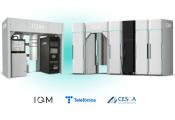NSF National Quantum Virtual Laboratory Advances with $5M Funding for 5 Pilot Projects
Aug. 12, 2024 — Realizing practical advantages and societal benefits from quantum-scale phenomena has been a long-sought milestone in quantum information science. The U.S. National Science Foundation today announced the initial $5 million investment across five pilot projects designed to help reach that milestone by taking the first steps toward creating the NSF National Quantum Virtual Laboratory (NQVL), a first-of-its-kind national resource to enable faster discovery and development of use-inspired quantum technologies.
With initial 12-month timelines, the five new pilot projects — funded at $1 million each — are led by quantum experts and others with diverse backgrounds spanning academia, industry, national labs and government. Five more pilot projects are expected to be announced later this year. The pilot project teams will be invited to compete for larger awards anticipated to fund NQVL’s design and development as a federated resource, bringing together assets that will enable a diversity of quantum-focused research and development.
NQVL will broaden access to specialized research infrastructure by functioning as a geographically distributed national resource. NQVL will grow and adapt to seize emerging opportunities and accelerate the translation of fundamental science and engineering into practical applications codesigned by a broad and diverse user community that spans computing, networking and sensing.
Throughout its life cycle, NQVL will provide workforce training and education opportunities to grow the U.S. STEM workforce, which will eventually lead the industries of the future. Democratizing access and building national quantum science capacity is part of NSF’s strategy to fulfill the scientific and technological advancements identified in 2018’s “National Quantum Initiative Act.”
The pilot project teams will be invited to submit proposals for NSF’s latest NQVL funding solicitation. The teams selected to receive NSF funding will design and use testbeds to refine their methodology, create prototypes of quantum-based technologies and advance their projects to the next stage. The team’s activities will be coordinated by a central hub that NSF expects to select later in the NQVL development process.
The first five NQVL pilot projects are:
Wide-Area Quantum Network to Demonstrate Quantum Advantage (SCY-QNet): Led by Stony Brook University in collaboration with Columbia University, Yale University and Brookhaven National Laboratory, the team aims to build a long-distance 10-node quantum network to demonstrate quantum advantage through quantum communication and distributed quantum processing. Those technological advancements would help enable secure and privacy-preserving long-distance communication systems.
Quantum Advantage-Class Trapped Ion system (QACTI): Led by Duke University in collaboration with the University of Chicago, Tufts University, North Carolina State University and North Carolina Agricultural and Technical State University, the team will pursue the creation of a 256-qubit ion trap quantum computing system. The system would be controllable over the internet and capable of running a wide range of quantum simulations and computations.
Deep Learning on Programmable Quantum Computers (DLPQC): Led by the Massachusetts Institute of Technology in collaboration with Harvard University, the University of California Los Angeles and the University of Maryland, the team seeks to develop quantum computing platforms with more than 100 qubits for error-corrected computing capable of complex many-body analysis to solve problems in chemistry, advanced materials and physics.
Quantum Sensing and Imaging Lab (Q-SAIL): Led by the University of California Los Angeles in collaboration with the University of Delaware, California Institute of Technology and the Massachusetts Institute of Technology, the team aims to develop quantum sensors based on two-dimensional trapped-ion arrays. Such sensors have the potential to substantially advance frequency metrology, with applications including telecommunications and navigation, terahertz imaging used in astronomy and medicine, and other areas.
Quantum Computing Applications of Photonics (QCAP): Led by the University of New Mexico in collaboration with New Mexico State University, Sandia National Laboratories, Los Alamos National Laboratory, Skorpios Technologies Inc. and Hoonify Technologies Inc., the team’s goal is to make quantum computers on chips using monolithically integrated quantum photonics to eventually develop this technology into a commercially viable product through partnership with industry.




































